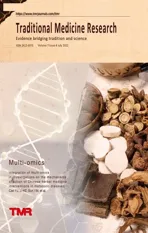Quality evaluation of Pinelliae Rhizoma using network pharmacology and multicomponent quantitative analysis
2022-06-28XinYangLiDiLiangXueQianZhangXiaoHuanLiMiaoShaXueMingZhangLanPingGuoWenYuanGaoXiaLi
Xin-Yang Li,Di Liang,Xue-Qian Zhang,Xiao-Huan Li,Miao Sha,Xue-Ming Zhang,Lan-Ping Guo,Wen-Yuan Gao,4,Xia Li*
1Tianjin Key Laboratory for Modern Drug Delivery&High-Efficiency,School of Pharmaceutical Science and Technology,Tianjin University,Tianjin 300193,China.2Key Laboratory of Modern Chinese Medicine Resources Research Enterprises, Tianjin 300402, China.3National Resource Center for Chinese Materia Medica,Academy of Chinese Medical Sciences,Beijing 100700,China.4College of Pharmacy,Qinghai Minzu University,Qinghai 810007,China.
Abstract Background: Pinelliae Rhizoma (Banxia) is a valuable traditional Chinese medicine, and its quality issues are related to the safety and effectiveness of the medicine.Several pharmacological experiments have shown that Pinelliae Rhizoma has anti-inflammatory activity, but the specific chemical components remain unclear. Methods: In the present study,network pharmacology was used to analyze the potential active ingredients and molecular mechanisms of Pinelliae Rhizoma’s anti-inflammatory activity.A new approach to simultaneously determine eight components using high performance liquid chromatography –photo-diode array was developed to evaluate the quality of Pinelliae Rhizoma and different processed Pinelliae Rhizoma products. Results: Twelve active ingredients were identified from Pinelliae Rhizoma, and β-sitosterol may have a greater effect than the other active ingredients.Gene Ontology and Kyoto Encyclopedia of Genes and Genomes enrichment analyses revealed the main pathways associated with Pinelliae Rhizoma’s mechanism for treating inflammation.Additionally, the β-sitosterol content in different processed Pinelliae Rhizoma products decreased significantly, and the level of five nucleosides in Pinelliae Rhizoma was significantly higher than that of the processed Pinelliae Rhizoma products.The 6-gingerol content was detected in eight Pinelliae Rhizoma Praeparatum cum Zingibere et Alumine batches with different origins, and liquiritin and liquiritigenin levels were detected in eight batches of Pinelliae Rhizoma Praeparatum with different origins. Conclusion: Pinelliae Rhizoma quality was affected by different regions and different processing methods, and this research provides a reference for Pinelliae Rhizoma quality evaluation.
Keywords: Pinelliae Rhizoma; anti-inflammation; network pharmacology; HPLC; quality evaluation
Background
Pinelliae Rhizoma, calle d Banxia in Chinese, is the dry tuber ofPinelliaternata(Thunb.) Breit (Figure 1).The first recorded report ofPinelliae Rhizomause is in “Fifty-Two Prescriptions”, which was written before 168 B.C.E.(author unknown) [1].After the Song Dynasty (960–1279 C.E.),Pinelliae Rhizomawas more widely used in clinical applications,and its effect of reducing phlegm is fully understood.With the development of modern medicine,Pinelliae Rhizomais often used to treat various phlegm syndromes, vomiting, and nausea.There are many active ingredients inPinelliae Rhizomaincluding nucleosides,alkaloids, organic acids, and β-sitosterol, and it has antitussive,antiemetic, anti-inflammatory, and other pharmacological activities[2, 3].Pinelliae Rhizomahas a long history as a traditional Chinese medicine (TCM) for inflammation and relieving cough [4].Although the therapeutic effect ofPinelliae Rhizomais attractive, the potential active ingredients and molecular mechanisms involved in antiinflammation remain unclear.Its multiple active ingredients have become a key barrier for the modernization ofPinelliae Rhizoma.
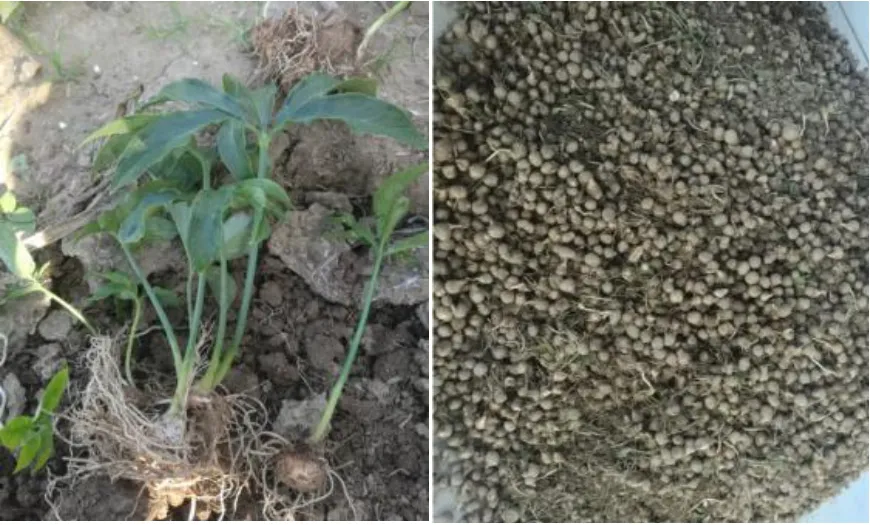
Figure 1 The whole Pinellia ternata (Thunb.) Breit.plant and its medicinal part
TCM has great advantages in treating complex diseases by acting upon various target proteins via multiple pathways [5].TCM can trigger a complex biological network in which different chemical components could have synergistic effects on one or more target proteins [6, 7].Therefore, it is not easy to determine the potential active ingredients and molecular mechanisms of action in TCM using regular methods.Network pharmacology is an emerging field that integrates multiple disciplines and techniques such as topology,computational omics, and genomics and explores potential mechanisms and relationships by constructing multiple network models [8].Multiple-target identification by network pharmacology is used to predict the main potential active constituents and targeted disease pathways of consequence in medicinal plants [9].Using this approach, studies have made much progress in exploring the roles of TCM in treating diseases[9–11].
Owing to the complexity of TCM, its quality cannot be evaluated comprehensively using single-index detection.The 2020 edition of theChinese Pharmacopoeiaremoved the regulation on content determination ofPinelliae Rhizoma, and thus, finding new content determination indicators has become an urgent problem that needs to be solved.Multi-component quantitative analysis is an efficient and holistic method to evaluate the quality of TCM.The main effect ofPinelliae Rhizomais “antiemetic and expectorant”, and nucleosides mainly promote its properties that “[reduce] adverse effects and[relieve] vomiting” [12].Additionally,Pinelliae Rhizoma Praeparatum(Fabanxia in Chinese) is processed with licorice andPinelliae Rhizoma,and thus, liquiritin and liquiritigenin can be used as its indicator components [13].Pinelliae Rhizoma Praeparatum cum Zingibere et Alumine(Jiangbanxia in Chinese) is processed with ginger andPinelliae Rhizoma, and thus, 6-gingerol can be used as its indicator components [14].To further improve the quality evaluation standard forPinelliae Rhizomaand different processedPinelliae Rhizomaproducts, a reliable high performance liquid chromatography –photo-diode array (HPLC-PDA) analysis method was proposed for the simultaneous determination of eight compounds (cytidine, adenosine,uridine, guanosine, adenine, liquiritin, liquiritigenin, and 6-gingerol).
In this study, 32 batches ofPinelliae Rhizomaand different processedPinelliae Rhizomaproducts from different regions were collected, and a network pharmacology-based method was used to explore the potential active components and mechanisms ofPinelliae Rhizomain treating inflammation.We also used a multi-component quantitative analysis to evaluate the quality ofPinelliae Rhizomaand different processedPinelliae Rhizomaproducts, which aims to provide direction for quality standards research on different processedPinelliae Rhizomaproducts.
Materials and methods
Materials and reagents
Medicinal herbs.Pinelliae Rhizomamaterials were collected from three provinces (Gansu, Shanxi, and Hubei) in China.Different processedPinelliae Rhizomamaterials were obtained from the retail website Taobao, and these materials were identified as the dried tuber fromPinellia ternata(Thunb.) Breit.by Professor Wenyuan Gao,School of Pharmaceutical Science and Technology, Tianjin University.Information about the samples is presented in Supplementary Table S1.
Standard substances.Cytidine, adenosine, uridine, guanosine,adenine, liquiritin, liquiritigenin, 6-gingerol, and β-sitosterol were obtained from Shanghai Standard Technology Co., Ltd.(Shanghai,China; purity ≥98.0%).Ultrapure water was produced by a Milli-Q system (Millipore, Bedford, MA, USA).HPLC grade acetonitrile was purchased from Concord Technology Co., Ltd.(Tianjin, China).Other reagents were of analytical grade.
Instruments.A Shimadzu LC-2030C HPLC system equipped with a binary solvent delivery pump (Shimadzu, Japan) was used.Additionally, a CP225D Sartorius analytical balance (Beijing Sartorius Instrument System Co., Ltd., Beijing, China), LG-04 high-speed Chinese medicine pulverizer (Jinhua, China), RE-200A rotary evaporator (Shanghai Yarong Biochemical Instrument Factory,Shanghai, China), and a UV/Vis spectrophotometer (Shanghai Metash Instruments Co., Ltd., Shanghai, China) were used.
Pinelliae Rhizoma network pharmacology
Ingredients database construction.Pinelliae Rhizomaingredients were collected from the traditional chinese medicines systems pharmacology database and analysis platform (TCMSP,http://lsp.nwu.edu.cn/tcmspsearch.php) database using the keyword“Banxia”.
Screening for active ingredients.Absorption, distribution,metabolism, and excretion, which are also called “ADME”, drug properties can predict a compound’s pharmacokinetic profile and minimize its potential drug-drug interactions [15].Clinically, TCM is usually administered orally.Oral bioavailability (OB) and drug similarity (DL) are the main variables that affect drug absorption across the gastrointestinal mucosa.Specifically, compounds with an OB ≥30% and a DL ≥0.18 were selected as candidate compounds for further analysis because molecules with an OB ≥ 30% are considered to have higher oral absorption and use, and the average index of molecules with biological properties in the DrugBank database was 0.18.In this study, the components in the database that did not meet both conditions were excluded from further analysis.
Identification of drug targets.Genes related to inflammation were obtained using the GeneCards (https://www.genecards.org/)platform, and the condition for the selected species wasHomo sapiens.Protein targets of the ingredients were retrieved and validated in accordance with the TCMSP.The obtained target protein was entered into the UniPort database (http://www.uniprot.org/) and a search was performed, thereby obtaining the standardized gene name.The Venny 2.1 (http://bioinfogp.cnb.csic.es/tools/venny/index.html)online tool was used to mapPinelliae Rhizoma’s active ingredient targets and inflammatory disease targets.The intersection target of these two parts was defined as the intersection gene, which may be the target gene that links thePinelliae Rhizomaactive ingredients with inflammation, and it may be a node forPinelliae Rhizomato exert its therapeutic effect.
Protein-protein interaction (PPI) network construction.The PPI network model was constructed using the string database online software (http://string.db.org/).The search terms “multiple protein”and “Homo sapiens” were selected, and then the intersection gene information was input along with the lowest interaction threshold,which was “medium confidence (0.4)”, and the default settings were used for the other parameters to obtain the PPI network data.The information obtained was imported into Cytoscape 3.8.0 software(U.S.National Institute of General Medical Sciences,https://cytoscape.org/) to draw the interaction network.
Gene Ontology (GO) and pathway enrichment analysis of targets.GO annotation was used to define and describe the three aspects of the gene product functions, which were biological processes (BPs),cell components (CCs), and molecular functions (MFs).The Kyoto Encyclopedia of Genes and Genomes (KEGG) is a database that integrates genome, chemistry, and system function information.To systematically analyze the biological process of inflammation, GO and KEGG analyses was performed for further validation.To investigate the biological effects of targets on inflammation by regulating specific pathways, significant pathways with a threshold ofP≤0.01 were screened for clustering analysis.The above analysis was performed using the functional annotation tool Metascape(http://metascape.org/) and bioinformatics(http://www.bioinformatics.com.cn/).
β-Sitosterol content
The main sterol component inPinelliae Rhizoma, which is β-sitosterol,has the effects of relieving cough and lowering blood pressure as well as anti-cancer, anti-inflammatory, and antioxidant properties [16],which can be used as a quality evaluation standard forPinelliae Rhizomaand different processedPinelliae Rhizomaproducts.
Test solution preparation.PowderedPinelliae Rhizoma(0.4 g) was accurately weighed, and 20 mL of ethyl acetate was added to it and cold-soaked overnight, and the filtrate was then collected.The samples underwent extraction twice and the filtrates were combined.Ethyl acetate was recovered, and the residue was diluted to a volume of 10 mL using ethyl acetate.This was the test solution.
Reference solution preparation.β-Sitosterol (5 mg), which had been dried to a constant weight, was accurately weighed, dissolved in ethyl acetate, and diluted to 50 mL.This was the 100 μg/mL reference solution.
Ultraviolet absorption wavelength measurement.The reference solution (0.5 mL) was accurately measured and placed into a test tube, evaporated in a water bath, and cooled to room temperature.Then, 4 mL of H2SO4was added to the samples in a water bath at 50 °C for 10 min.After cooling, the samples were diluted to 5 mL using H2SO4.H2SO4was used as a blank sample, and the detection wavelength was 420 nm.
Multi-component quantitative analysis of Pinelliae Rhizoma and different processed Pinelliae Rhizoma
HPLC-PDA analytical conditions.A Shimadzu LC-2030C HPLC system with a binary solvent delivery pump (Shimadzu, Japan), an auto-sampling manager, and a photodiode array detector were used.Chromatographic separation was performed using an Agilent ODS-100V column (4.6 mm × 250 mm, 5 μm, Tosoh, Japan).The mobile phase was composed of solvent A (ultrapure water) and solvent B(acetonitrile) with a linear gradient, as follows: 0–5 min with 0.1% B;5–10 min with 0.1%–0.5% B; 10–21 min with 0.5%–1% B; 21–35 min with 1%–3% B; 35–55 min with 3%–5% B; 55–75 min with 5%–40% B; and 75–100 min with 40%–60% B.The detection wavelength,flow rate, injection volume, and chromatographic column temperature were set as 265 nm, 1 mL/min, 10 μL, and 30°C,respectively.
Solution preparation.Pinelliae Rhizomawas ground into a homogeneous powder (passed through a 60-mesh sieve), and 2 g of sample powder was accurately weighed and extracted using 30 mL of a 50% methanol aqueous solution in an ultrasonic water bath at room temperature for 60 min.The extraction solution was centrifuged at 1,000 ×gfor 10 min to collect the supernatant.
Each standard was precisely weighed and dissolved in methanol to obtain a single stock solution (1 mg/mL), and then 0.15 mL, 0.2 mL,0.3 mL, 0.4 mL, 0.6 mL, and 0.8 mL of the single stock solution was subsequently diluted into 1 mL using methanol to determine the standard curve.
All the solutions were stored at 4 °C and filtered through a 0.22-µm membrane filter before HPLC analysis.The sample retention time and the standard were compared, and the content was calculated on the basis of the standard curve.
Statistical analysis
Data were presented as the mean ± standard deviation using triplicate measurements.Significant difference analysis was performed using an analysis of variance with Duncan’s test, andP<0.05 was considered to be statistically significant.Statistical analysis was conducted using SPSS (version 20.0, IBM Corp., Armonk, NY,USA) and Origin Pro 9.0 (Origin Lab Corp., Northampton, MA, USA).
Results
Network pharmacology analysis
Active compound screening.Twelve potential compounds (OB ≥30%, DL ≥ 0.18) inPinelliae Rhizomawere identified using the TCMSP.Relevant information about the 12 active compounds is shown in Supplementary Table S2.
Pinelliae Rhizoma target identification.The potential targets ofPinelliae Rhizomaactive compounds were retrieved and validated on the basis of the TCMSP.Subsequently, these targets were normalized and related PPIs were predicted using the Uniprot and String databases.The occurrence and development of inflammation is a complex process involving regulation of multiple genes and proteins.Screening TCMSP and GeneCards revealed 86 active ingredientrelated targets and 1,371 inflammation-related targets.On the basis of Venny, 33 targets that were directly and indirectly associated with inflammation were obtained.Detailed information on the obtained protein targets is presented in Supplementary Table S3.
Target-active ingredients network.To determine the multicomponent and multi-target synergistic effects inPinelliae Rhizomaand to explore their mechanisms, a compound-target network analysis was conducted.The common target-active ingredients network is shown in Figure 2.The network was constructed using 98 nodes (12 active compounds and 86 protein targets) and 160 edges.The nodes represent a single medicine, active ingredients, and their targets, and the edges represent the relationship between the single medicine, active ingredients, and their targets.The topological analysis degree value was chosen to identify important ingredients and related targets.On the basis of the degree value (Supplementary Table S2), we identified the following five pivotal active ingredients:β-sitosterol (35), baicalein (32), stigmasterol (30), cavidine (24), and coniferin (19).The largest degree value was β-sitosterol (35),indicating that, among these active ingredients, its effect may be the most significant.
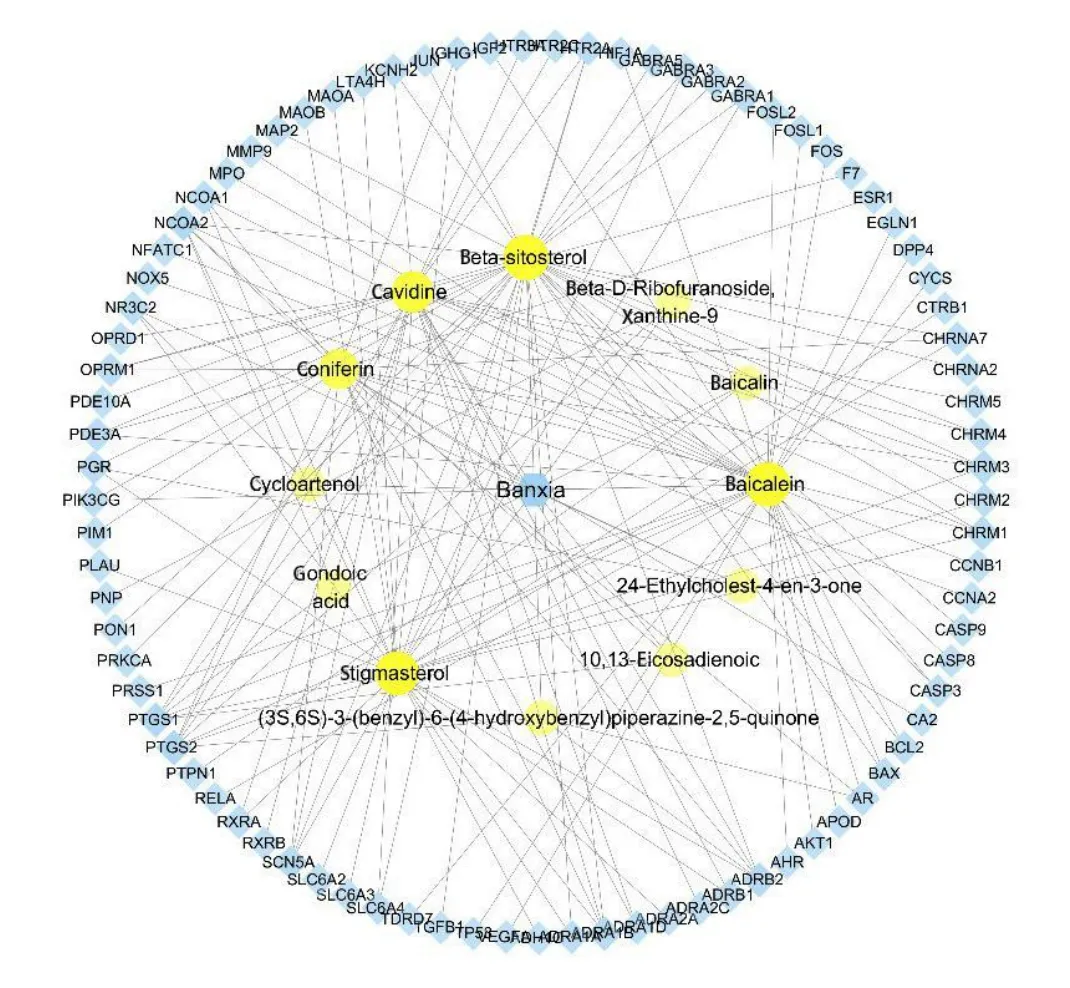
Figure 2 Drug-target-active ingredients network.The blue hexagon node represents a single herb from Pinelliae Rhizoma, blue rectangle nodes represent the common targets of inflammation and Pinelliae Rhizoma, and yellow round nodes represent the active ingredients related to the common targets.
PPI network.PPI network analysis of the inflammation targets was performed using the String database online service platform, and the results are shown in Figure 3.The PPI network comprised 33 nodes and 171 edges, with an average degree value of 10.4, where the nodes represent proteins and each edge represents the interaction among the proteins.The thickness of the line represents the strength of the PPI; the thicker the line, the stronger is the interaction.Additionally, the greater the degree value, the more critical was its role, which may be the key target protein forPinelliae Rhizomain treating inflammation.The top six proteins were serine/threonine kinase 1 (AKT1), vascular endothelial growth factor A, the protooncogene FOS, matrix metallopeptidase 9, tumor protein P53, and prostaglandin-endoperoxide synthase 2, which may play important roles in inflammation development and progression.
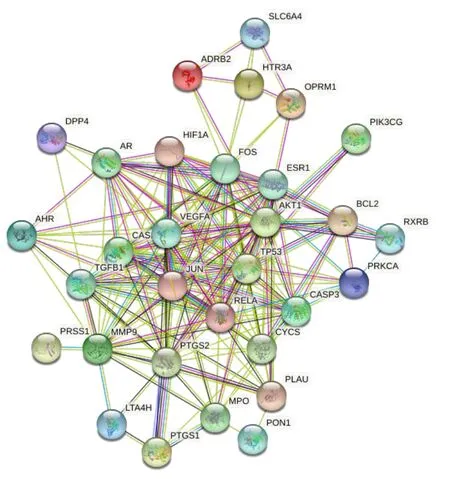
Figure 3 PPI network.PPI, protein-protein interaction.
Target pathway analysis.To explore the mechanism ofPinelliae Rhizomafor treating inflammation, we used the Bioinformatics platform to perform GO and KEGG functional enrichment analyses on the 33 common targets.We obtained 719 BPs, 45 MFs, 33 CCs, and 190 KEGGs (P≤0.01).The most significant terms in BPs, MFs, and CCs and the KEGG pathway are shown in Figure 4.GO enrichment analysis demonstrated that the common targets were mainly related to responses to toxic substances, oxidative stress, and lipopolysaccharide in addition to the cell response to organic cyclic compounds and regulating cell adhesion.The main MFs of common targets were protein binding, enzyme binding, transcription factor binding, protein isomerization activity, and cytokine activity.The cellular component may be mainly activated in the transcription factor complexes, membrane rafts, secretory granule lumen, and cell bodies (Figure 4A).The most significant pathways for the common targets were the cancer-related pathways, advanced glycation end product – receptor for advanced glycation end product (AGE-RAGE)signaling pathway, and the estrogen signaling pathway(Figure 4B).
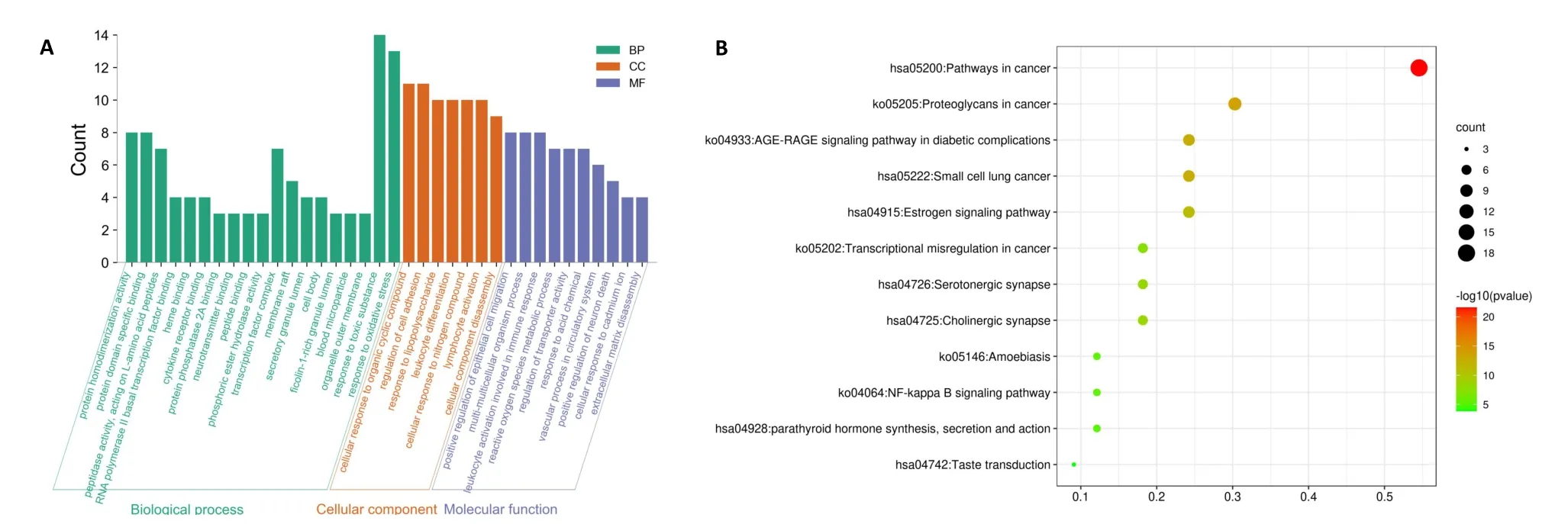
Figure 4 GO and KEGG analysis of common targets.(A) Significantly enriched terms in BPs, MFs, CCs; “count” is the number of screened targets.(B) The 12 pathways with the lowest adjusted p values.The X-axis was the gene ratio of the term and the Y-axis was the name of the terms.The darker the color, the larger the adjusted p value; the larger the circle, the greater the number of target genes in the term.GO, Gene Ontology; BPs,biological processes; CCs, cell components; MFs, molecular functions; KEGG, Kyoto Encyclopedia of Genes and Genomes.
β-Sitosterol content
Standard curve preparation.The reference solution (0.25, 0.5, 1,1.5, 2, and 2.5 mL) was used to measure β-sitosterol absorbance at 420 nm.The concentration was the abscissa and the absorbance was the ordinate, and the linear regression equation for β-sitosterol was y= 0.01x + 0.0274, with R2= 0.9984, which showed a good linear relationship between concentration and absorbance in the concentration range of 20–70 μg/mL.
β-Sitosterol in Pinelliae Rhizoma and different processed Pinelliae Rhizoma products.The reaction between steroids and acid under anhydrous conditions can produce obvious color changes, such as the sulfuric acid – acetic anhydride reaction, sulfuric acid – chloroform reaction, and glacial acetic acid – zinc chloride reaction [17].In this research, concentrated sulfuric acid was used as the developer, and the β-sitosterol content inPinelliae Rhizomaand different processedPinelliae Rhizomaproducts was determined using UV/Vis spectrophotometry.The results showed that the UV/Vis spectrophotometric method to determine β-sitosterol had a fast reaction speed, stable color development, an obvious phenomenon,and a good effect (Table 1).
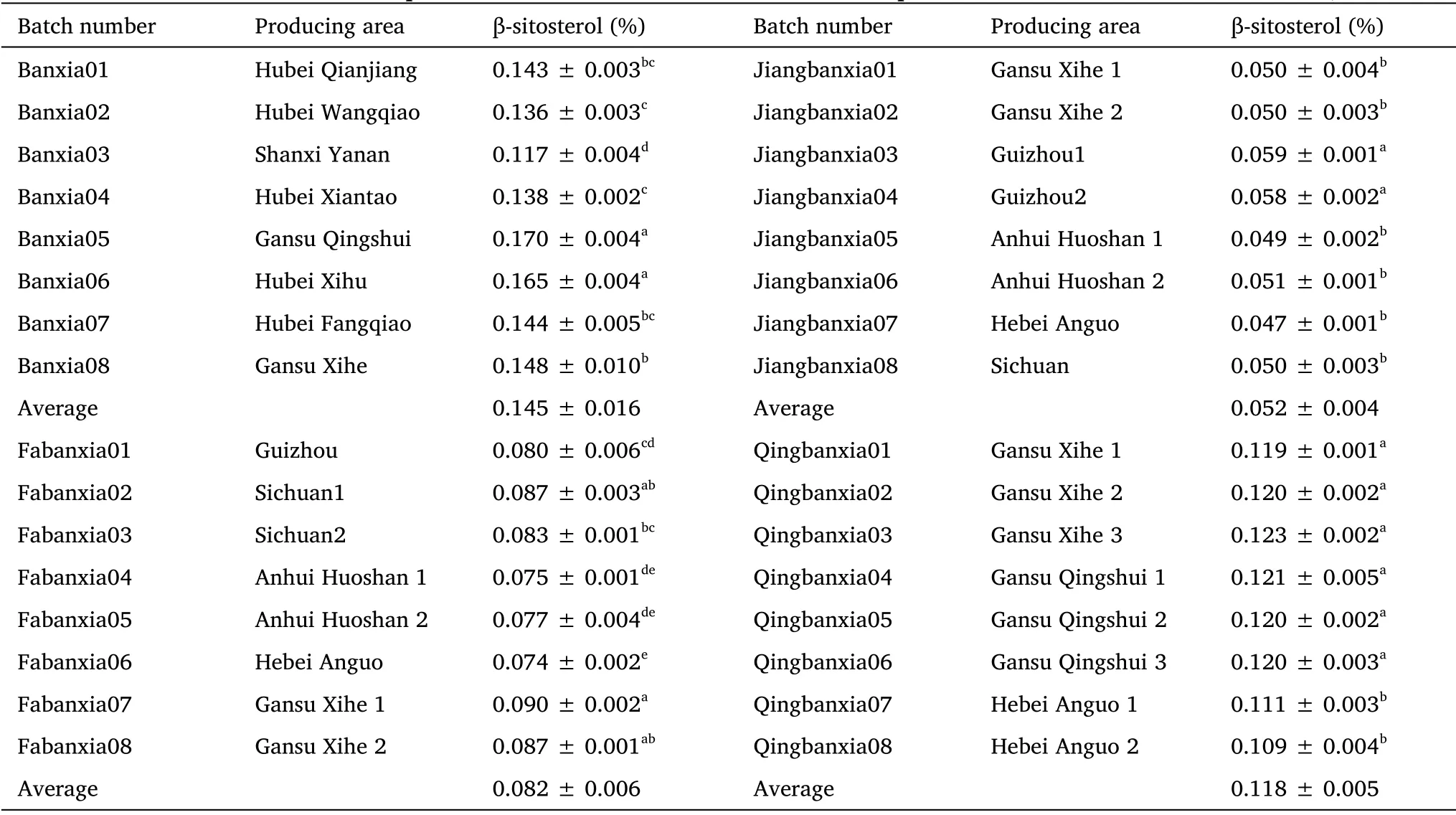
Table 1 Results of the content of β-sitosterol of Pinelliae Rhizoma and different processed Pinelliae Rhizoma (mean ± SD,n = 3)
β-Sitosterol showed anti-inflammatory, anti-cancer, anti-oxidation,and anti-hyperlipidemia effects and prevented high blood pressure[16, 18].The β-sitosterol content is also used as a quality standard to evaluatePinelliae Rhizomaand different processedPinelliae Rhizomaproducts, and it is often used as an index during thePinelliae Rhizomaextraction and preparation process.Network pharmacology analysis showed that β-sitosterol was a main chemical components that is related to anti-inflammation inPinelliae Rhizoma.
This study showed that the β-sitosterol content inPinelliae Rhizomaand different processedPinelliae Rhizomaproducts was significantly different.The β-sitosterol content inPinelliae Rhizomawas the highest,followed in descending order byPinelliae Rhizoma Praeparatum cum Alumine(Qingbanxia) andPinelliae Rhizoma Praeparatum, andPinelliae Rhizoma Praeparatum cum Zingibere et Alumine, which are the processedPinelliae Rhizomaproducts of interest, indicating thatPinelliae Rhizomahad the highest content of β-sitosterol, but after processing, the β-sitosterol content was reduced.Among them,Pinelliae Rhizoma Praeparatum cum Alumineprocessing retained the most active ingredient (i.e., β-sitosterol).The β-sitosterol content inPinelliae Rhizoma Praeparatum cum Zingibere et Alumine, which was processed by heating, was lower compared with that ofPinelliae Rhizoma Praeparatum cum Alumine, indicating that heating may negatively influence the β-sitosterol content [19].
Establishment of analytical methods
Optimization of HPLC-PDA conditions.In this research, the following two types of reverse-phase C18columns were investigated:TSKgel ODS-100V column (4.6 mm × 250 mm, 5 μm) and Kromasil 100-5 C18column (4.6 mm × 250 mm, 5 μm).The former was used in this work to obtain better resolution and peak symmetry.Different mobile phase compositions were evaluated, and acetonitrile had a better peak shape compared with methanol.Formic acid and ultrapure water were also compared to improve peak symmetry.Thus,acetonitrile and ultrapure water were selected as the most appropriate mobile phases to achieve better separation.The chemical structures of the eight components are presented in Supplementary Figure S1.These components exhibited an appropriate absorption at 265 nm, and they also had a stable baseline.Thus, 265 nm was selected as the detection wavelength.Moreover, the injection volume,flow rate, and chromatographic column temperature were set at 10 μL,1.0 mL/min, and 30 °C, respectively.
HPLC-PDA methodology validation.The peak area relative standard deviation values for the eight components from each sample were calculated to estimate precision, stability, and repeatability.The results are summarized in Table 2.The relative standard deviation values from the peak areas were less than 0.79% and 3.64% for precision, less than 1.06% and 2.55% for repeatability, and less than 0.81% and 3.23% for stability.These results demonstrated that the developed method was feasible and suitable for quantitative analysis ofPinelliae Rhizoma(Supplementary Figure S2).

Table 2 Results of precision, stability, repeatability and recovery rates of HPLC analytical method
Quantitative determination results of eight components in Pinelliae Rhizoma and different processed Pinelliae Rhizoma products
Many active ingredients have been isolated fromPinelliae Rhizoma,such as nucleosides, alkaloids, organic acids, polysaccharides, fats,volatile oils, starch, and β-sitosterol.Many studies have indicated that aPinelliae Rhizomaaqueous solution contains a variety of nucleoside components, such as inosine, uridine, guanosine, xanthine,uracil, hypoxanthine, and thymidine.These components have important pharmacological activities and are important cellular substances that maintain life, including regulating immunity,regulating brain cell metabolism, calming the central nervous system,and participating in the process of DNA metabolism, in addition to anti-inflammatory, anti-tumor, anti-platelet aggregation, and other properties[17].
In this research, we simultaneously determined eight components fromPinelliae Rhizoma,Pinelliae Rhizoma Praeparatum cum Zingibere et Alumine,Pinelliae Rhizoma Praeparatum, andPinelliae Rhizoma Praeparatum cum Alumineusing the same method to control and evaluate the quality ofPinelliae Rhizomaand various processedPinelliae Rhizomaproducts that are on the market (i.e.,Pinelliae Rhizoma Praeparatum cum Zingibere et Alumine,Pinelliae Rhizoma Praeparatum, andPinelliae Rhizoma Praeparatum cum Alumine).On the basis of the determination for five nucleoside components (adenosine,uridine, guanosine, cytidine, and adenine), liquiritin and liquiritigenin were added as indicator components forPinelliae Rhizoma Praeparatumand 6-gingerol was added as an indicator forPinelliae Rhizoma Praeparatum cum Zingibere et Alumine.The samples were quantified using the calibration curve that was fitted using a linear regression analysis in accordance with the external standard method (Supplementary Figure S3).The levels of the eight compounds in 32 batches ofPinelliae Rhizomaand the three processedPinelliae Rhizomaproducts (Pinelliae Rhizoma Praeparatum cum Zingibere et Alumine,Pinelliae Rhizoma Praeparatum, andPinelliae Rhizoma Praeparatum cum Alumine)are presented in Table 3.
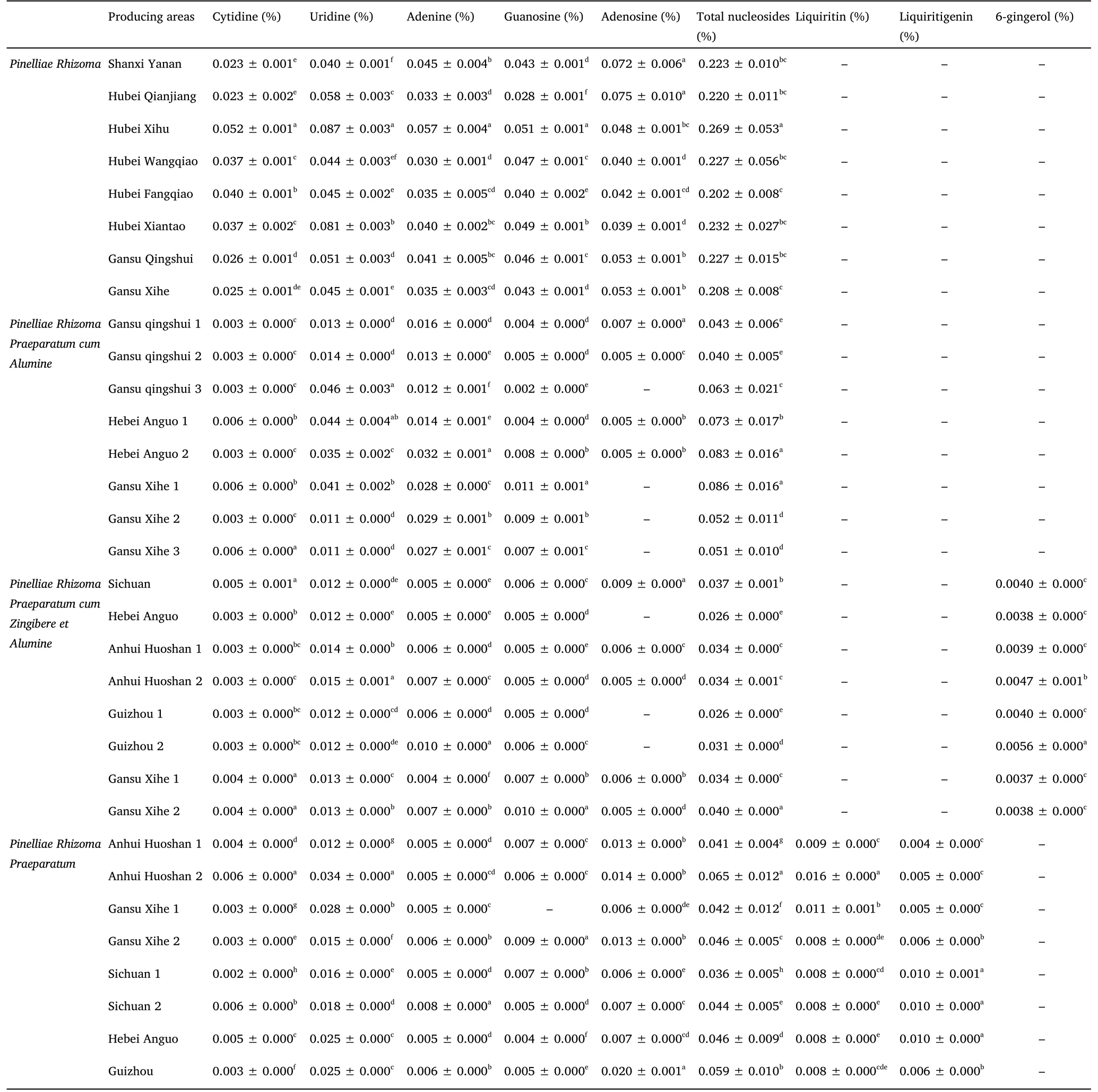
Table 3 Results of quantitative determination of eight components in Pinelliae Rhizoma (mean ±SD, n =3)
Among the eight batches ofPinelliae Rhizomasamples, the total content of the five nucleosides inPinelliae Rhizomafrom Hubei Province was 0.202%–0.269% and that from Gansu Province was 0.208%–0.227%.Among them,Pinelliae Rhizomafrom Gansu Xihe was processed using sulfur fumigation, and it had a lower total nucleoside content compared withPinelliae Rhizomafrom Hubei Provence.Wang et al.[21] found that the content of uracil, cytidine,hypoxanthine, and thymidine decreased with an increasing of the degree of sulfur fumigation.The total nucleoside content inPinelliae Rhizomafrom various areas was different, which was related to factors such as climatic conditions, environmental factors, harvest time, and drying method.Among the eight batches ofPinelliae Rhizoma Praeparatum cum Aluminesamples, the total content of the five nucleosides inPinelliae Rhizoma Praeparatum cum Aluminefrom Gansu Province was 0.04%–0.086% and that from Hebei Province was 0.073%–0.083%.Pinelliae Rhizoma Praeparatum cum Aluminewas soaked or boiled with 8% alum solution, which could account for the observed decrease in water-soluble nucleoside components.
Among the eight batches ofPinelliae Rhizoma Praeparatum cum Zingibere et Aluminesamples, the total content of the five nucleosides inPinelliae Rhizoma Praeparatum cum Zingibere et Aluminefrom Guizhou Province, Gansu Province, Anhui Province, Hebei Province,and Sichuan Province was 0.026%–0.031%, 0.073%–0.083%, 0.034%,0.026%, and 0.037%.However, adenosine was not detected in the two batches ofPinelliae Rhizoma Praeparatum cum Zingibere et Aluminefrom Hebei and Guizhou.Additionally, 6-gingerol was detected in the eight batches ofPinelliae Rhizoma Praeparatum cum Zingibere et Alumine, and the content range was 0.0037%–0.0056%.Pinelliae Rhizoma Praeparatum cum Zingibere et Aluminewas processed by soaking it in an alum solution, and if the soaking time were too long,the effective ingredients would be decreased.Therefore, it is necessary to strictly control the soaking time and minimize the loss of effective ingredients during processing.In the eight batches ofPinelliae Rhizoma Praeparatumsamples, the total content of the five nucleosides inPinelliae Rhizoma Praeparatumfrom Anhui Province,Gansu Province, Sichuan Province, Hebei Province, and Guizhou Province was 0.041%–0.065%, 0.042%–0.046%, 0.036%–0.044%,0.046%, and 0.059%.Additionally, the total liquiritigenin and liquiritin content from different areas was 0.013%–0.021%.Pinelliae Rhizoma Praeparatumwas soaked in lime water during processing,which could also reduce the nucleoside content.
Hierarchical cluster analysis(HCA)
HCA is a method that can divide datasets into clusters [22].In this research, which was based on the content of nine compounds (i.e.,guanosine, adenosine, cytidine, uridine, adenine, liquiritigenin,liquiritin, 6-gingerol, and β-sitosterol) among all the samples, HCA was used to divide the datasets into several clusters.The results are shown in Figure 5.The 32 batches ofPinelliae Rhizomaand different processedPinelliae Rhizomaproducts were classified into four main groups.Cluster 1 mainly consisted of thePinelliae Rhizomasamples collected from different areas, and the content of the nine components ranged from 0.349% to 0.412%.Cluster 2 mainly consisted of thePinelliae Rhizoma Praeparatumsamples collected from different areas, and the content of the nine components ranged from 0.131% to 0.173%.Cluster 3 was mainly composed of thePinelliae Rhizoma Praeparatum cum Aluminesamples collected from different areas, and the content of the nine components ranged from 0.16% to 0.206%.Cluster 4 was mainly composed of thePinelliae Rhizoma Praeparatum cum Zingibere et Aluminesamples collected from different areas, and the content of the nine components ranged from 0.079%to 0.097%.This indicates that the above nine ingredients can be used to separate the fourPinelliae Rhizomaprocessed products.
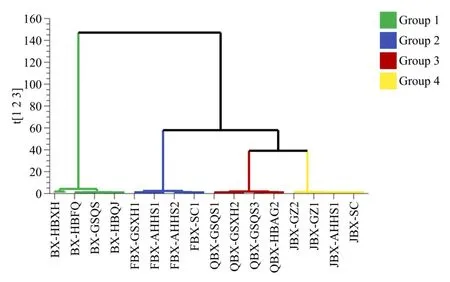
Figure 5 Dendrogram of the contents of nine compounds in Pinelliae Rhizoma and different processed products.Green, Banxia(BX) from different areas; blue, Fabanxia (FBX) from different areas;Red, Qingbanxia (QBX) from different areas; Yellow, Jiangbanxia(JBX) from different areas.HBXH, Hubei Xihui; HBQJ, Hubei Qianjiang; HBWQ, Hubei Wangqiao; HBFQ, Hubei Fangqiao; HBXT,Hubei Xiantao; GSQS, Gansu Qingshui; GSXH, Gansu Xihe; HEAG,Hebei Anguo; SC, Sichuan; GZ, Guizhou; AHHS, Anhui Huoshan.Banxia, Pinelliae Rhizoma; Fabanxia, Pinelliae Rhizoma is processed with licorice; Jiangbanxia, Pinelliae Rhizoma is processed with ginger;Qingbanxia, Pinelliae Rhizoma is processed with alunite.
Principal component analysis(PCA)
A large amount of data can be standardized using PCA.This method mainly converts a large amount of data into several principal component factors through dimensionality reduction, which simplifies the data set and preserves the most important aspects of the data [22].In this study, the contents of nine active constituents inPinelliae Rhizomaand differently processedPinelliae Rhizomawere analyzed using PCA.On the basis of the principle that the eigenvalue of extracted principal components should be greater than one and the cumulative contribution rate should be greater than 80%, all data from the nine active compound contents were simplified into two principal components using PCA [23].In PCA (Figure 6), the first two principal components (PC1 and PC2) accounted for 82% of the total variance.Among them, the contribution rate of PC1 was 59.5%,which mainly included guanosine, adenosine, cytidine, uridine,adenine, and β-sitosterol.The contribution rate of PC2 was 22.5%,which mainly included liquiritigenin, liquiritin, and 6-gingerol.

Figure 6 Loading (A) and score (B) plots of PCA analysis.Group 1, BX from a different area; group 2, FBX from a different area; group 3, QBX from a different area; group 4, JBX from a different area.Horizontal and vertical indicate a similar distance for samples influenced by the principal components (P1 or P2).SXYA, Shanxi Yanan; HBQJ, Hubei Qianjiang; HBXH, Hubei Xihui; HBWQ, Hubei Wangqiao; HBFQ, Hubei Fangqiao; HBXT, Hubei Xiantao; GSQS, Gansu Qingshui; GSXH, Gansu Xihe; HEAG, Hebei Anguo; SC, Sichuan; GZ, Guizhou; AHHS, Anhui Huoshan.BX, Banxia; FBX, Fabanxia; JBX, Jiangbanxia; QBX, Qingbanxia; Banxia, Pinelliae Rhizoma; Fabanxia, Pinelliae Rhizoma is processed with licorice; Jiangbanxia,Pinelliae Rhizoma is processed with ginger; Qingbanxia,Pinelliae Rhizoma is processed with alunite.
Additionally, a scores plot of 32 batches ofPinelliae Rhizomaand differently processedPinelliae Rhizomaproducts was obtained, as observed in Figure 6.These samples were divided into four parts.Pinelliae Rhizomasamples (group 1) were located in the middle right part of the diagram, whilePinelliae Rhizoma Praeparatum cum Aluminesamples (group 3) were located in the middle part, indicating thatPinelliae Rhizomafrom different areas possessed higher a content of guanosine, adenosine, cytidine, uridine, adenine, and β-sitosterol compared with that ofPinelliae Rhizoma Praeparatum cum Alumine.Pinelliae Rhizoma Praeparatumsamples (group 2) were grouped in the top left part of the diagram, indicating thatPinelliae Rhizoma Praeparatumfrom different areas possessed a high content of both liquiritigenin and liquiritin, whilePinelliae Rhizoma Praeparatum cum Zingibere et Aluminesamples (group 4) were grouped in the lower left part, indicating thatPinelliae Rhizoma Praeparatum cum Zingibere et Aluminefrom different areas possessed a high content of 6-gingerol.The PCA plot results were consistent with those of the HCA plot,which showed that there were differences betweenPinelliae Rhizomaand differently processedPinelliae Rhizoma.
Discussion
Pinelliae Rhizomahas been widely used in TCM as an expectorant,antitussive, and anti-inflammatory.However, there is no current indepth research on the active ingredients inPinelliae Rhizoma, and there is no information on content determination forPinelliae Rhizomain the 2020 edition of theChinese Pharmacopoeia.Therefore,we aimed to study the small-molecule components inPinelliae Rhizomaas the index components to provide a reference forPinelliae Rhizoma’s quality standard.
In this research, we studied the active components, potential targets, and molecular mechanisms ofPinelliae Rhizomausing network pharmacology.We screened out the active components ofPinelliae Rhizomaand predicted the targets.Among them, β-sitosterol corresponded to the most disease targets, which may be the main ingredient inPinelliae Rhizoma.Studies showed that β-sitosterol inhibited vascular endothelial cell adhesion molecules and their cellular expression, and attenuated nuclear factor kappa B phosphorylation, thus exerting an anti-inflammatory effect [24].AKT1, vascular endothelial growth factor A, FOS, matrix metallopeptidase 9, tumor protein P53, and prostaglandinendoperoxide synthase 2 may be the key anti-inflammatory targets inPinelliae Rhizoma.AKT1, which is also called serine/threonine kinase 1, is a known oncogene that can mediate activation of the nuclear factor kappa B inflammation signaling pathway [25], which can lead to the occurrence and progression of chronic atrophic gastritis [26].The cancer-related pathways, AGE-RAGE signaling pathway, and estrogen signaling pathway are mainly involved in KEGG-enriched pathways.In addition to its involvement in diabetes, the AGE-RAGE signaling pathway is also involved in neurological diseases, digestive system diseases, and tumors.AGE and its receptor RAGE are distributed in the gastric mucosa and gastric gland cells, and their excessive accumulation may activate downstream ligands or pathways related to inflammation and oxidative stress, leading to gastrointestinal dysfunction, gastric mucosal atrophy, and other diseases [27].
Currently, there is no standardized index component to evaluate the quality ofPinelliae Rhizoma, but nucleoside components have been widely used as an index component in this manner.Wu et al.[28] isolated inosine and guanosine from the water-soluble components ofPinelliae Rhizoma, and these were used asPinelliae Rhizomaindex components.Some scholars isolated thymidine and adenosine from the water-soluble components ofPinelliae Rhizoma;some scholars detected other nucleoside components such as cytidine,adenine, and uridine from the water extract ofPinelliae Rhizoma; and other scholars used HPLC methods to simultaneously detect xanthine,uracil, inosine, uridine, and guanosine inPinelliae Rhizomawatersoluble components [29].Recently, some scholars have established a one-test and multi-evaluation method for the four organic acids and six nucleosides inPinelliae Rhizomausing the ultra-performance liquid chromatography tandem mass spectrometry method.On the one hand, it can be used to determine the content ofPinelliae Rhizomafrom different producing areas, and on the other hand, it can provide a new method to controlPinelliae Rhizoma’s quality [30].A reliable HPLC-PDA method was established to simultaneously determine the content of five nucleosides (cytidine, uridine, adenine, guanosine,and adenosine), liquiritin, liquiritigenin, and 6-gingerol in differentPinelliae Rhizomadecoction pieces.The established method had good stability, repeatability, and precision, and thus, the detection results were scientific and reliable.Using a combination of HCA and PCA,the quality of these 32 batches of differentPinelliae Rhizomadecoction pieces was evaluated.The results showed that the nucleoside and β-sitosterol content decreased significantly after processing.The content determination method established in this study can provide a reference for revision of the newChinese Pharmacopoeiaedition.
Conclusion
In this study, we used network pharmacology analysis to screen 12 potential active ingredients ofPinelliae Rhizomaand established a method to identify β-sitosterol.Additionally, a reliable HPLC-PDA analytical method was established to identify guanosine, adenosine,cytidine, uridine, adenine, liquiritigenin, liquiritin, and 6-gingerol inPinelliae Rhizomaand various processedPinelliae Rhizomaproducts.A multi-component quantitative analysis indicated that the eight components inPinelliae Rhizomaand different processedPinelliae Rhizomaproducts from various producing areas showed different content levels.PCA and HCA results showed thatPinelliae Rhizomaand various processedPinelliae Rhizomaproducts can be distinguished on the basis of the above nine components.
杂志排行
Traditional Medicine Research的其它文章
- Integration of multi-omics in investigations on the mechanisms of action of Chinese herbal medicine interventions in metabolic diseases
- Active compounds in RenShenJian decoction ameliorate insulin resistance in vitro
- Inhibition of rat prostate smooth muscle contractility by extracts of Costus speciosus(crepe ginger)
- Biologically active components for cosmeceutical use extracted from Chaetomorpha aerea
- Advances in traditional Chinese medicine for respiratory disease therapy in 2021
- Toxicological advances of traditional medicine in 2021
